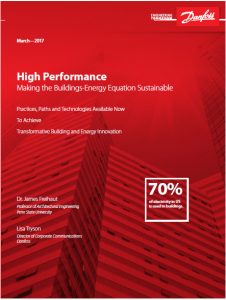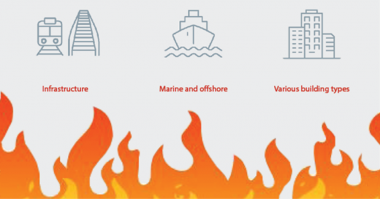Report developed with Dr. Freihaut of The Pennsylvania State University identifies a holistic approach as key to building transformation that revolutionizes energy productivity and economic growth
Danfoss, a leading manufacturer of high-efficiency electronic and mechanical components and controls for air-conditioning, heating, refrigeration, industrial, and water systems, today published a report on making the buildings-energy equation sustainable. The report, which was developed with Dr. James Freihaut, a professor of architectural engineering at The Pennsylvania State University, traces the path of high-performance buildings in the pursuit of sustainability and explores the potential impact of building transformation on energy productivity and the economy.
According to the report, buildings consume 70 percent of the electricity generated in the United States — 66 percent of which was generated from carbon-based fuels in 2015, 33 percent from coal, and 33 percent from natural gas. At the same time, predicted population growth and current low deployments of renewable energy sources will hinder the ability of countries around the world to jointly reach the United Nation’s target to reduce global temperature rise.
Transforming the building-energy profile today can not only combat climate challenges, but also reduce costs and improve economic security. However, building science, regulation, and practice will need to look beyond component improvements in order to yield greater increases in performance. The new vision requires buildings be viewed as a whole — composed of integrated systems and sub-systems, as able to be integrated with a larger community of buildings and with electricity generation and distributions systems, and as performing over a lifecycle and within a community.
The toolbox for such a transformation, the report suggests, are available today, including practices like integrative design, benchmarking, modelling, and labelling, as well as technologies like building automation, variable speed, combined heat and power, and energy storage.
“Transformation requires a new thinking about buildings and energy — a holistic approach that begins at birth and continues throughout the building lifecycle,” said Lisa Tryson, director of corporate communications at Danfoss. “We’re pleased to have partnered with Dr. Freihaut on this report, which underscores an important shift in the design, delivery, and maintenance of buildings and calls attention to the potential impacts on energy productivity, life quality, and economy. Deep transformation begins when the market is persuaded. This report aims to make that case.”
In January, Danfoss announced a partnership with The Pennsylvania State University to advance sustainable buildings and low-carbon communities. The collaborative Engineering Tomorrow’s Cities initiative, under the direction of Dr. Freihaut, will focus on enlarging the workforce required to create, maintain, and renew sustainable, low-carbon communities; advance the deployment of innovative technologies and designs to reduce carbon emissions; and highlight the important role of engineering in creating the sustainable commercial buildings and communities of tomorrow.






Comments